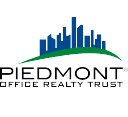/ factorpad.com / stocks / f72bpg.html
An ad-free and cookie-free website.
Our quantitative data points are meant to provide a high-level understanding of factors in equity risk models for Piedmont Office Realty Tru-A. Portfolio managers use these models to forecast risk, optimize portfolios and review performance.
We show how PDM stock compares to 2,000+ US-based stocks, and to peers in the Real Estate and Rental and Leasing sector and Lessors of Nonresidential Buildings (except Miniwarehouses) industry.
Please do not consider this data as investment advice. Data is downloaded from sources we deem reliable, but errors may occur.
 Piedmont Office Realty Trust, Inc. is an owner, manager, developer, redeveloper, and operator of high-quality, Class A office properties located primarily in select sub-markets within seven major Eastern U.S. office markets, with the majority of its revenue being generated from the Sunbelt. Its geographically-diversified, approximately $5 billion portfolio is currently comprised of approximately 17 million square feet. The Company is a fully-integrated, self-managed real estate investment trust (REIT) with local management offices in each of its markets and is investment-grade rated by S&P Global Ratings (BBB) and Moody's (Baa2). As of December 31, 2020, approximately 64% of the company's portfolio was ENERGY STAR certified and approximately 43% was LEED certified.
Piedmont Office Realty Trust, Inc. is an owner, manager, developer, redeveloper, and operator of high-quality, Class A office properties located primarily in select sub-markets within seven major Eastern U.S. office markets, with the majority of its revenue being generated from the Sunbelt. Its geographically-diversified, approximately $5 billion portfolio is currently comprised of approximately 17 million square feet. The Company is a fully-integrated, self-managed real estate investment trust (REIT) with local management offices in each of its markets and is investment-grade rated by S&P Global Ratings (BBB) and Moody's (Baa2). As of December 31, 2020, approximately 64% of the company's portfolio was ENERGY STAR certified and approximately 43% was LEED certified.
Many of the following risk metrics are standardized and transformed into quantitative factors in institutional-level risk models.
Rankings below represent percentiles from 1 to 100, with 1 being the lowest rating of risk.
Stocks with higher beta exhibit higher sensitivity to the ups and downs in the market. (↑↑)
Stocks with higher market capitalization often have lower risk. (↑↓)
Higher average daily dollar volume over the past 30 days implies lower liquidity risk. (↑↓)
Higher price momentum stocks, aka recent winners, equate to lower risk for many investors. (↑↓)
Style risk factors often include measures of profitability and payout levels.
Companies with higher earnings generally provide lower risk. (↑↓)
Companies with higher dividend yields, if sustaintable, are perceived to have lower risk. (↑↓)
/ factorpad.com / stocks / f72bpg.html
A newly-updated free resource. Connect and refer a friend today.